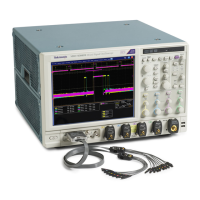Commands Listed in Alphabetical Order
Related Commands
MEASUrement:R
EFLevel:PERCent:HIGH, MEASUrement:REFLevel:PERCent:
LOW, MEASUrement:REFLevel:PERCent:MID<x>,
Arguments
HIStogram sets the high and low reference levels to the most common values
either above or below the mid point, depending on whether the high reference
point or the low reference point is being defined. Because the statistical approach
ignores short-term aberrations, such as overshoot or ringing, the histogram method
is the best setting for examining pulses.
MEAN sets the high and low reference levels to the mean values using all values
either above or below the midpoint, depending of whether it is defining the high
or low reference level. The selection is best used for examining eye patterns.
MINMax uses the highest and lowest values of the waveform record. This selection
is best for examining waveforms w ith no large, flat portions of a common value,
such as sine waves and triangle waves.
Examples
MEASUREMENT:METHOD HISTOGRAM specifies that the high and low reference
levels are set statistically.
MEASUREMENT:METHOD? might return :MEASUREMENT:METHOD MINMAX,
indicating that the reference levels are set to MIN and MAX.
MEASUrement:NOISe
This command sets or queries whether the noise measurement is made on the high
or low level of the waveform. Sending this command is equivalent to selecting
Ref Levs > Eye > Top Level or Base Level in the Comm tab of the Measurement
Setup dialog box. The Eye section is displayed only if you have an eye-pattern or
optical measurement defined.
Conditions
This command is only valid if the instrument has Option MTM is installed
Group
Measurement
Syntax
MEASUrement:NOISe {HIGH|LOW}
MEASUrement:NOISe?
Arguments
HIGH argument causes the measurement for noise to be taken at the high level
of the waveform.
LOW argument causes the measurement for noise to be taken at the low level of
the waveform.
2-402 DPO7000, DPO70000/B and DSA7000/B Series Programmer Manual

